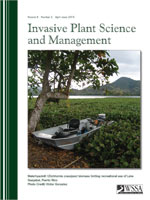The invasive aquatic plant hydrilla rapidly spread through the 28,500 ha Kissimmee Chain of Lakes (KCOL) system in Florida in the late 1980s and early 1990s. Large-scale herbicide treatments with fluridone were initiated in 1993 and resulted in widespread reduction in hydrilla; however, by 2000, sustained use of fluridone resulted in dominance of fluridone-resistant strains of hydrilla throughout these lakes. The last large-scale fluridone applications on the KCOL were conducted in 2004, and in 2012, a sampling effort was initiated to determine the status of fluridone-resistant strains of hydrilla given an 8-yr period with no further selection pressure from fluridone. A total of 260 sites were sampled on the lakes during March, May, September, and December 2012. Plants were returned to the lab and exposed to fluridone at concentrations of 5, 10, and 20 μg L−1 and a pulse-amplitude-modulated (PAM) fluorometer was utilized to measure fluorescence yield of new shoot tissue growth following a 14-d exposure period. Results indicate that 80 to 90% of the sites sampled on the four lakes of the Kissimmee Chain remain resistant to fluridone. Three distinct patterns of response to fluridone were noted, suggesting that susceptible, moderately tolerant, and highly tolerant strains of hydrilla currently coexist on these lakes. Although fluridone-susceptible plants were present on the KCOL, this study clearly demonstrates that most of the hydrilla remained resistant despite an 8-yr period with no fluridone selection pressure.
Nomenclature: Fluridone; hydrilla, Hydrilla verticillata (L.f). Royle HYLLI.
Management Implications: In this case study we evaluated the frequency of fluridone-resistant hydrilla on the 28,500 ha Kissimmee Chain of Lakes, FL, 8 yr following the last large-scale fluridone application. Resource managers had become highly reliant on whole-lake use patterns of fluridone, and they particularly favored the cost effectiveness, selectivity, low-use volumes, and the limited water-use restrictions on the label. We hypothesized that a series of hurricanes and large-scale hydrilla management with alternate herbicide modes of action would result in a higher frequency of fluridone-susceptible hydrilla given the 8-yr absence of fluridone pressure. The source of the susceptible hydrilla was an extensive tuber bank that can persist in the sediments for years. Our results suggest that fluridone-resistant hydrilla remains dominant throughout the KCOL. Although we did find areas of the lake with susceptible plants, resistant hydrilla continued to make up 80 to 90% of the overall population. Numerous managers have inquired about the potential for Florida lakes to revert to fluridone-susceptible populations. Our results suggest this is an unlikely scenario in the KCOL because the resistant plants remain both widespread and dominant.





